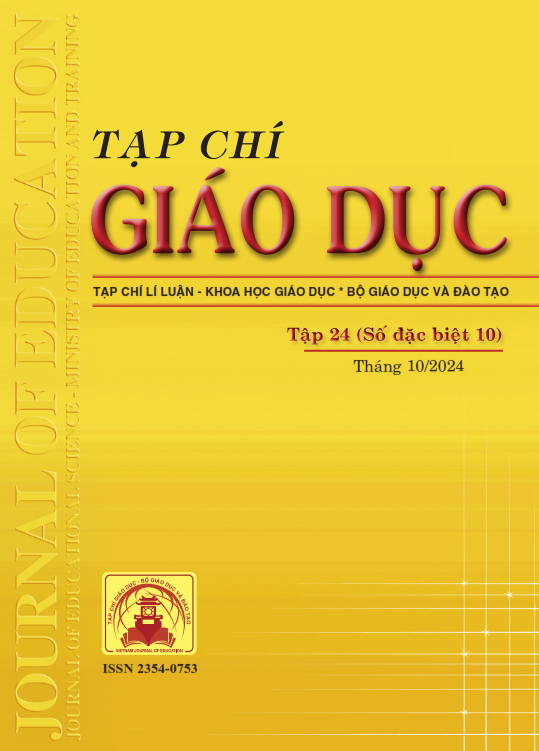Khả năng ghi nhớ từ vựng và nhận thức của học sinh trung học phổ thông học tiếng Anh như ngoại ngữ khi sử dụng ứng dụng Duolingo: Nghiên cứu tại Đồng bằng sông Cửu Long
Tóm tắt
Research into Duolingo app implementation has addressed its role in English as a Foreign Language (EFL) high school students’ vocabulary retention and EFL high school students’ perceptions of it in the digital era. This paper, therefore, reports a mixed-methods approach integrating both quantitative and qualitative techniques to examine how the Duolingo app affected EFL high school students’ vocabulary retention and how they perceived the Duolingo app. Pretests, posttests, and focus-group interviews were utilized to collect data. Participants in this study were forty-eight EFL high school students in the Mekong Delta region, equally divided into a control group and an experimental group. The findings reveal that both groups improved their vocabulary retention, but students in the experimental group achieved higher results in the posttest. Therefore, using the Duolingo app can help students’ vocabulary retention. However, only a few students could increase their Word Levels. Besides, EFL high school students believed that the Duolingo app brought many benefits, which helped them enhance their English skills inside and outside the classroom. However, some challenges, such as advertisements and Internet connections, were also indicated.
Tài liệu tham khảo
Ahmed, H. B. E. (2016). Duolingo as a bilingual learning app: A case study. Arab World English Journal, 7(2), 255-267. https://dx.doi.org/10.24093/awej/vol7no2.17
Bogdan, D. R. (2016). Duolingo as an “Aid” to second-language learning an individual case study. New York: Pearson Education Group, 63, 199-212.
Burston, J. (2015) Twenty years of MALL project implementation: A meta-analysis of learning outcomes. ReCALL, 27(1), 4-20. https://doi.org/10.1017/S0958344014000159
Clark, M. (2013). The use of technology to support vocabulary development of English language learners. Education Masters.
Council of Europe (2001). Common European framework of reference for languages: Learning, teaching, assessment. Cambridge University Press.
Dang, T. N. Y. (2020). Vietnamese non-English major EFL university students’ receptive knowledge of the most frequent English words. VNU Journal of Foreign Studies, 36(3), 1-11. https://doi.org/10.25073/2525-2445/vnufs.4553
Duong, T. M. (2022). Insights into ESP Vocabulary Learning Strategies Used by Vietnamese Tertiary Students. Journal of Language and Education, 8(1), 38-49. https://doi.org/10.17323/jle.2022.10924
Duong, T. M., Tran, T. Q., & Nguyen, T. T. P. (2021). Non-English majored students’ use of English vocabulary learning strategies with technology-enhanced language learning tools. Asian Journal of University Education,17(4), 455-463. https://doi.org/10.24191/ajue.v17i4.16252
Eady, M., & Lockyer, L. (2013). Learning to teach in the primary school. Tools for Learning: Technology and Teaching Strategies, 71-89.
Gass, S. (1999). Discussion: Incidental vocabulary learning. Studies in Second Language Acquisition, 21(2), 319-333.
Ghazal, L. (2007). Learning vocabulary in EFL contexts through vocabulary learning strategies. Novitas-Royal, 1(2), 84-91.
Gilakjani, A. P., & Sabouri, N. B. (2017). Advantages of using computer in teaching English pronunciation. International Journal of Research in English Education, 2(3), 78-85. https://doi.org/10.18869/acadpub.ijree.2.3.78
Handrianto, C., Rasool, S., Rahman, M. A., Mustain, M., & Ilhami, A. (2021). Teachers self-efficacy and classroom management in community learning centre (CLC) Sarawak. Spektrum: Jurnal Pendidikan Luar Sekolah (PLS), 9(2), 154-163. https://doi.org/10.24036/spektrumpls.v9i2.111963
Hatch, E., & Brown, C. (1995). Vocabulary, semantics, and language education. Cambridge University Press.
Hoang, V. V. (2022). Interpreting MOET’s 2018 general education English curriculum. VNU Journal of Foreign Studies, 38(5), 1-22. https://doi.org/10.25073/2525-2445/vnufs.4866
Jaelani, A., & Sutari, D. R. (2021). Students’ perception of using Duolingo application as a media in learning vocabulary. Bogor English Student and Teacher (BEST) Conference, 2, 40-47.
Kukulska-Hulme, A. (2009). Will mobile learning change language learning?. ReCALL, 21(2), 157-165. https://doi.org/10.1017/S0958344009000202
Lambert, J., & Cuper, P. (2008). Multimedia technologies and familiar spaces: 21st century teaching for 21st century. Contemporary Issues in Technology and Teacher Education, 8(3), 264-276.
Littlejohn, A., Margaryan, A., & Vojt, G. (2010). Exploring students’ use of ICT and expectations of learning methods. Electronic Journal of e-Learning, 8(1), 13-20.
Luu, T. T. (2011). An Empirical research on self-learning vocabulary. Theory and Practice in Language Studies. 1(2), 1688-1695. https://doi.org/10.4304/tpls.1.12.1688-1695
McCarthy, M. (1990). Vocabulary. Oxford: Oxford University Press.
Muddin, A. (2018). The use of Duolingo to improve students’ vocabulary. Doctoral dissertation, UIN Ar-Raniry Banda Aceh.
Nemati, A. (2010). Active and passive vocabulary knowledge: The effect of years of instruction. The Asian EFL Journal Quarterly, 12(1), 30-46.
Norris, D. (2017). Short-term memory and long-term memory are still different. Psychological Bulletin, 143(9), 992-1009. https://doi.org/10.1037/bul0000108
Ngo, C. L. (2019). Language learning strategies among Vietnamese EFL High School students. Indonesian Journal of English Language Teaching, 14(1), 55-70.
Nguyen, N. C., & Vu, V. D. (2019). An exploratory study on perspectives of Vietnamese experienced teachers and student teachers toward teachers’ code-switching. Cambridge Open-Review Educational Research Journal, 6, 66-79.
Nguyen, N. T. (2014). Learner autonomy in language learning: Teachers’ beliefs. Doctoral dissertation, Queensland University of Technology.
Nguyen, T. K., & Thai, D. C. (2024). A study on Duolingo mobile applications to improve EFL students’ listening comprehension performances. European Journal of Alternative Education Studies, 9(1). http://dx.doi.org/10.46827/ejae.v9i1.5342
Nguyen, T. M. H., & Webb, S. (2017). Examining second language receptive knowledge of collocation and factors that affect learning. Language Teaching Research, 21(3), 298-320. https://doi.org/10.1177/1362168816639619
Schmitt, N. (2000). Vocabulary in language teaching. Cambridge University Press.
Stavy, L. Z. D., Subon, F., & Unin, N. (2019). Using language games for vocabulary retention in a rural primary school in Sarawak. International Journal of Service Management and Sustainability (IJSMS), 4(2), 101-118. https://doi.org/10.24191/ijsms.v4i2.8067
Tran, H. Q. (2013). Figurative idiomatic competence: An analysis of EFL learners in Vietnam. Language Education in Asia, 4(1), 23-38.
Vu, D. V., & Peters, E. (2021). Vocabulary in English language learning, teaching, and testing in Vietnam: A review. Education Sciences, 11(9), 563. https://doi.org/10.3390/educsci11090563
Webb, S., Sasao, Y., & Ballance, O. (2017). The updated Vocabulary Levels Test. ITL-International Journal of Applied Linguistics, 168(1), 33-69. https://doi.org/10.1075/itl.168.1.02web
Đã Xuất bản
Cách trích dẫn
Số
Chuyên mục
Giấy phép

Tác phẩm này được cấp phép theo Ghi nhận tác giả của Creative Commons Giấy phép quốc tế 4.0 .












